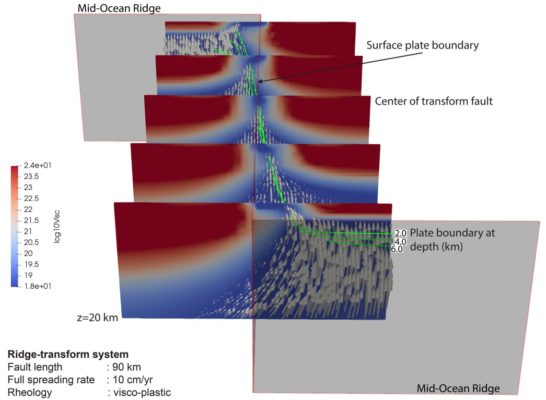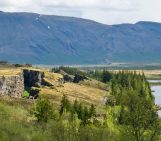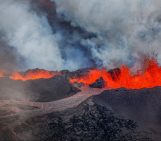
Yu Ren is a PhD candidate at GEOMAR Helmholtz Centre for Ocean Research Kiel, Germany. He uses three primary tools to study marine tectonics: geomorphology, seismology, and numerical modelling. His PhD project is on the structural and tectonic characterization of oceanic transform faults.
Oceanic transform faults (OTFs), usually considered as first-order tectonic segmentation of mid-ocean ridges, are among the most prominent tectonic structures under the deep oceans (Wilson, 1965). They are huge morphologic features which modify the surrounding rocks and sediments, and influence lithosphere hydrodynamics. Traditional plate tectonics assumes that OTFs are conservative plate boundaries where the oceanic lithosphere is neither formed nor destroyed (Sykes, 1967; Lachenbruch & Thompson, 1972), as the opposite plates are moving horizontally past each other. Furthermore, seafloor subsidence predicts that the lithosphere along OTFs cools and deepens as a function of the age of the oceanic crust (Sandwell, 1984). However, it might be worth noting that, in the past decades, understanding of the ridge-transform dynamics was quite limited due to the poor data coverage of the remote oceanic area.

Figure 1. Schematic illustration of the tectonic elements within oceanic transform systems. Credit: Ito, 2021
A recent compilation of shipborne multibeam bathymetric data from 41 OTFs, covering spreading rate from ultraslow to fast, enables researchers to study the morphology of global OTFs in a more systematic way (Grevemeyer et al., 2021). Within the transform system, a transform deformation zone (TDZ) several kilometers wide runs along the main strike-slip fault. Statistics on the depth of ocean bottom reveal that, independent of spreading rate, the seafloor within the TDZ is always deeper than that of its adjacent fracture zone (Figures 2a-b), in contrast to the prediction of thermal subsidence that the seabed deepens as the crust continues to age. Such observation infers that the depth difference between the transform and its associated fracture zone is an intrinsic feature of transform systems, which have been overly simplified in the original framework for plate tectonics. Furthermore, depth of the OTF seems to correlate with spreading rate and age offset (Figures 2c-d), which demands further investigation on the mechanism of the deformation of OTFs.

Figure 2. Statistics for the depth of OTFs and their associated facture zones. Credit: Grevemeyer et al., 2021
Using the open-source code ASPECT, 3-D numerical models with nonlinear visco-plastic rheology were performed to explore the transform dynamics controlling the correlations revealed by the statistical observation on seafloor depth (Grevemeyer et al., 2021). As a result, an oblique shear zone at depth, indicated by the geodynamic simulations, infers the extensional component within the OTF system (Figure 3) that significantly affects mantle upwelling and brittle thinning (i.e., deformation of the brittle lithosphere). From the perspective of thermal conduction, there are significant temperature contrasts within the transform system (Collette, 1974; Turcotte, 1974; Sandwell, 1984), where the old, cold lithosphere cools the young near-ridge material, producing an oblique shear zone at depth (Furlong et al., 2001). Thus, the extension across transform (Furlong et al., 2001; Grevemeyer et al., 2021) results from the mismatch between the deep shear zone and the near-surface transform strike (Figure 3), causing thinning and upwelling within transform systems (e.g., Whitmarsh & Calvert, 1986; Cessaro & Hussong, 1986; Wilcock et al., 1990; Escartín & Cannat, 1999). Therefore, it was suggested that the extension across the OTF is the key process that thins the lithosphere and deepens the seafloor within the TDZ, hence the observation that seafloor within the TDZ is always deeper than that of its adjacent fracture zone (Grevemeyer et al., 2021).

Figure 3. Brittle stretching and thinning within oceanic transform system predicted by numerical simulations. Credit: Grevemeyer et al., 2021
Furthermore, geodynamic models of a group of OTFs with different spreading rates and age offsets predict that the tectonic thinning caused by the cross-transform extension scales with age offset (Figure 4). Such correlation predicted by numerical simulations is consistent with the observation that depth of the OTFs systematically scales with age offset. The fine consistency between statistical observation and model prediction infers that extension across the OTFs plays an active role in the transform dynamics and systematically deepens the seafloor.

Figure 4. Correlation between extension at OTFs and age offsets, extracted from geodynamic models. Credit: Grevemeyer et al., 2021
Outlook
Based on the good consistency between observational results and modelling prediction, Grevemeyer et al. (2021) challenged the traditional concept that OTFs are 2-D conservative plate boundaries, and suggested that extension across OTFs significantly influences the tectonic structures of transform systems. This finding provides new clues to study the origin and evolution of OTFs. Also, it’s important to conduct further interdisciplinary investigations (microseismicity, multi-channel seismics, magnetism, gravity, sampling, modelling, etc.) of the extensional tectonics and volcanic reconstruction within transform systems (Ito, 2021).
References
Cessaro, R. K., & Hussong, D. M. (1986), Transform seismicity at the intersection of the oceanographer fracture zone and the Mid-Atlantic Ridge. Journal of Geophysical Research, 91(B5), 4839–4853. doi:10.1029/JB091iB05p04839
Collette, B. (1974), Thermal contraction joints in a spreading seafloor as origin of fracture zones. Nature, 251, 299–300. doi: 10.1038/251299a0
Escartín, J., & Cannat, M. (1999), Ultramafic exposures and the gravity signature of the lithosphere near the Fifteen-Twenty Fracture Zone (Mid-Atlantic Ridge, 14°–16.5°N). Earth and Planetary Science Letters, 171(3), 411–424. doi: 10.1016/S0012-821X(99)00169-7
Furlong, K. P., Sheaffer, S. D., & Malservisi, R. (2001), Thermal-rheological controls on deformation within oceanic transforms. Geological Society, London, Special Publications, 186, 65–83. doi: 10.1144/GSL.SP.2001.186.01.05
Grevemeyer, I., Rüpke, L. H., Morgan, J. P., Iyer, K., & Devey, C. W. (2021), Extensional tectonics and two-stage crustal accretion at oceanic transform faults. Nature, 591, 402–407. doi: 10.1038/s41586-021-03278-9
Ito, G. (2021), Oceanic fault zones reconstructed. Nature, 591, 376–377. doi: 10.1038/d41586-021-00639-2
Lachenbruch, A. H., & Thompson, G. A. (1972), Oceanic ridges and transform faults: Their intersection angles and resistance to plate motion. Earth and Planetary Science Letters, 15(2), 116–122. doi: 10.1016/0012-821X(72)90051-9
Sandwell, D. T. (1984), Thermomechanical evolution of oceanic fracture zones. Journal of Geophysical Research, 89(B13), 11401–11413. doi:10.1029/JB089iB13p11401
Sykes, L. R. (1967), Mechanism of earthquakes and nature of faulting on the mid-oceanic ridges. Journal of Geophysical Research, 72(8), 2131–2153. doi: 10.1029/JZ072i008p02131
Turcotte, D. L. (1974), Are transform faults thermal contraction cracks? Journal of Geophysical Research, 79(17), 2573–2577. doi: 10.1029/JB079i017p02573
Whitmarsh, R. B., & Calvert, A. J. (1986), Crustal structure of Atlantic fracture zones — I. The Charlie-Gibbs Fracture Zone. Geophysical Journal International, 85(1), 107–138. doi: 10.1111/j.1365-246X.1986.tb05174.x
Wilcock, W. S. D., Purdy, G. M., & Solomon, S. C. (1990), Microearthquake evidence for extension across the Kane Transform Fault. Journal of Geophysical Research, 95(B10), 15439–15462. doi:10.1029/JB095iB10p15439
Wilson, J. T. (1965), A new class of faults and their bearing on continental drift. Nature, 207, 343–347. doi: 10.1038/207343a0



